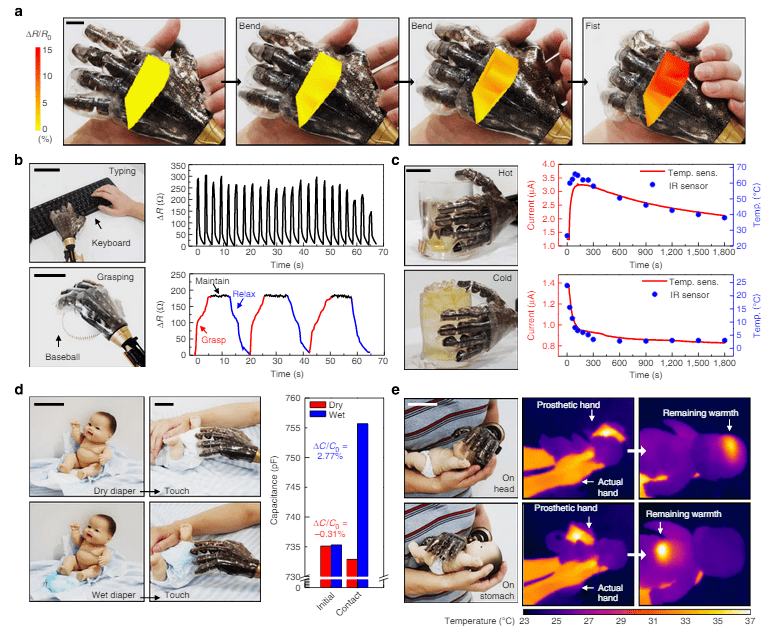Brain-computer interfaces have helped prosthetics go a long, long way. ZME Science showed you a couple of such examples, like the case of a mechanical arm remotely controlled by a man using only using thoughts or the mind-blowing high-tech prosthetic by DARPA that empowered a veteran who had lost him limb to perform all sorts of complex tasks previously unimaginable for a prosthetic. The trend is to develop mechanical replacements that mimic the real limb as closely as possible, however, beyond their practical use our limbs are important for another important reason – sensing. South Korean researchers are at the very frontline of this line of research; they report a smart prosthetic skin instrumented with ultrathin, single crystalline silicon nanoribbon (SiNR) strain, pressure and temperature sensor arrays. This artificial skin can be stretched across a whole prosthetic and might one day complete the whole array of needs a prosthetic must meet: practicality, aestheticism and sensation.
Prosthetic touch

In the paper’s abstract, the Seoul National University team acknowledges that while significant progress has been made “understanding the neural circuits underlying mechanical and thermal sensation, replicating these capabilities in artificial skin and prosthetics remains challenging.” For instance, ZME Science reported last year how another team, this time from the University of Chicago in the US, demonstrated a viable prosthetic that relays back sensory input in real time. This way, if you instruct the prosthetic arm to squish a ball with your thoughts, you also get a signal back from the arm to the brain so that you know if you need to keep squeezing or loosen. It’s a fantastic display of feedback. Like the system developed by the Americans, the South Korean smart skin also relies on highly sensitive sensors.
[ALSO SEE] Learning how to use brain-computer interfaces is as easy as waving a hand
After much careful planning, the sensor array was designed to have geometries that will allow it to stretch. This way, the whole array can be easily stretched and people might feel both humidity and temperature where the sensor comes into contact with matter, be it air or some surface like a hot plate. This ‘sensation’ is then transmitted from the sensor to the body through ultrathin stretchable nanowire-based electrodes.

The researchers also recognize that our tactile or haptic abilities aren’t the same throughout the surface of the skin. The skin is more sensitive in some parts than others, like the fingertips and lips since these areas have more receptor cells. As such, the team is considering “location specific optimization of sensors and actuators in artificial skin and prosthetics”.
Ultimately, though, the skin needs to relay sensitivity to prosthetic’s user. This is also the most challenging part. To achieve this goal, the signals captured across various sensor arrays must be processed and transmitted to stimulate the corresponding peripheral nervous system. For this to work, the charge delivered to the nerves must be delivered from low impedance in the multi-electrode array. There are also quite a few mechanical and biological challenges. The skin is subjected to tremendous amounts of strain and other mechanical motions. The smart skin needs to preserve mechanically conformal contacts and prevent scar formation arisen from mechenical mistmatch between the biological tissues and the electrode arrays.
The stretchable was described in the journal Nature.






